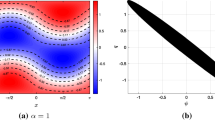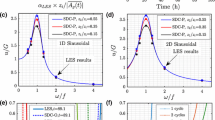Abstract
We investigate energy transfer of air–water interactions and develop a numerical method that captures its temporal variability and generates and tracks the short waves that form in the water surface as a result of the air–water turbulence. We solve a novel system of balance equations derived from the Navier–Stokes equations known as moment field equations. The main advantage of our approach is that we do not assume a priori that the stochastic random variables that quantify the turbulent energy transfer between air and water are Gaussian. We generate non-conservative multifractal measures of turbulent energy transfer using a recursive integration process and a self-affine velocity kernel. The kernel exactly satisfies the (duration limited) kinetic equation for waves as well as invariant scaling properties of the Navier–Stokes equations. This allows us to derive source terms for the moment field equations using a turbulent diffusion operator. The operator quantifies energy transfer along a space time path associated with pressure instabilities in the air–sea interface and transfers the statistical shape (or fractal dimension) of the atmosphere to the wind-sea. Because we use observational data to begin the recursive integration process, the ocean–atmosphere interaction is inherently built into the model. Numerical results from application of our methods to air–sea turbulence off the coast of New Jersey and New York indicate that our methods produce measures of turbulent energy transfer that match theory and observation, and, correspondingly, significant wave heights and average wave periods predicted by our model qualitatively match buoy data.












Similar content being viewed by others
Data availability
The data used in this investigation can be obtained at https://www.ndbc.noaa.gov.
References
Baker, G.R., Overman, E.A.: The art of scientific computing, Draft XVII, (2011)
Blake, E.S., Kimberlain, T.B., Berg, R.J., Cangialosi, J.P., Beven II, J.L.: Tropical Cyclone Report Hurricane Sandy (AL182012) 22-29 October 2012, National Hurricane Center, 12 February (2013)
Benzi, R., Paladin, G., Parisi, G., Vulpiani, A.: On the multifractal nature of fully developed turbulence and chaotic systems. J. Phys. A: Math. Gen. 17, 3521–3531 (1984)
Benzi, R., Ciliberto, S., Tripiccione, R., Baudet, C., Massaioli, F., Succi, S.: Extended self-similarity in turbulent flows. Phys. Rev. E 48, R29 (1993)
Cavaleri, L.: Wave modeling-missing the peaks. J. Phys. Oceanogr. 39, 2757–2778 (2009)
Cockburn, B., Shu, C.-W.: Runge-Kutta discontinuous Galerkin methods for convection-dominated problems. J. Sci. Comput. 16(3), 173–261 (2001)
Conroy, C.J., Kubatko, E.J., Nappi, A., Sebian, R., West, D., Mandli, K.T.: hp discontinuous Galerkin methods for parametric, wind-driven water wave models. Adv. Water Resour. 119, 70–83 (2018)
Conroy, C.J., Mandli, K.T., Kubatko, E.J.: Quantifying air-water turbulence with moment field equations. J. Fluid Mech. 1–35 (2021). https://doi.org/10.1017/jfm.2021.242
Dietrich, J.C., Zijlema, M., Westerink, J.J., Holthuijsen, L.H., Dawson, C., Luettich Jr., R.A., Jensen, R.E., Smith, J.M., Stelling, G.S., Stone, G.W.: Modeling hurricane waves and storm surge using integrally-coupled, scalable computations. Coast. Eng. 58, 45–65 (2011)
Dietrich, J.C., Tanaka, S., Westerink, J.J., Dawson, C.N., Luettich Jr., R.A., Zijlema, M., Holthuijsen, L.H., Smith, J.M., Westerink, L.G., Westerink, H.J.: Performance of the Unstructured-Mesh, SWAN+ADCIRC Model in Computing Hurricane Waves and Surge. J. Sci. Comput. 52(2), 468–497 (2012)
Dubuc, B., Quiniou, J.F., Roques-Carmes, C., Tricot, C., Zucker, S.W.: Evaluating the fractal dimension of profiles. Phys. Rev. A 39(3), 1500–1512 (1989)
Frisch, U.: Turbulence: the legacy of A.N. Kolmogorov, Cambridge University Press, (1996)
Hasselmann, K., Ross, D.B., Müller, P., Sell, W.: A Parametric Wave Prediction Model. J. Phys. Oceanogr. 6, 200–228 (1975)
Hentschel, H.G.E., Procaccia, I.: Fractal nature of turbulence as manifested in turbulent diffusion. Phys. Rev. A 27(2), 1266–1269 (1983)
Holthuijsen, L.H., Booij, N., Herbers, T.H.C.: A prediction model for stationary, short-crested waves in shallow water and ambient currents. Coast. Eng. 13, 23–54 (1989)
Holthuijsen, L.H.: Waves In Oceanic and Coastal Waters. Cambridge University Press, Cambridge (2007)
Janssen, P.: The Interaction of Ocean Waves and Wind. Cambridge University Press, Cambridge (2004)
Jensen, R.E., Cialone, A., Smith, J.M., Bryant, M.A., Hesser, T.J.: Regional wave modeling and evaluation for the North Atlantic coast comprehensive study, J. Waterway Port Coastal Ocean Eng. (2016), https://doi.org/10.1061/(ASCE)WW.1943-5460.0000342
Kolmogorov, A.N.: The local structure of turbulence in incompressible viscous fluid for very large Reynolds’ numbers. Doklady Akademiia Nauk SSSR 30, 301–305 (1941)
Kolmogorov, A.N.: On analytical methods in probability theory, Selected Works of A.N. Kolmogorov Volume II: Probability Theory and Mathematical Statistics, Springer Science+Business Media Dordrecht, pp.62-108, (1992)
Kubatko, E.J., Westerink, J.J., Dawson, C.: \(hp\) discontinuous Galerkin methods for advection dominated problems in shallow water flow. Comput. Methods Appl. Mech. Eng. 196, 437–451 (2006)
Kubatko, E.J., Yeager, B.A., Ketcheson, D.I.: Optimal Strong-Stability-Preserving Runge-Kutta Time Discretizations for Discontinuous Galerkin Methods. J. Sci. Comput. 60, 313–344 (2014)
LeVeque, R.J.: Finite volume methods for hyperbolic problems, Cambridge University Press, New York, (2004)
Liberto, T.D., Colle, B.A., Georgas, N., Blumberg, A.F., Taylor, A.A.: Verification of a multimodel storm surge ensemble around New York City and long island for the cool season. Wea. Forecast. 26, 922–939 (2011)
Mandelbrot, B.B.: Intermittent turbulence in self-similar cascades: Divergence of high moments and dimension of the carrier. J. Fluid Mech. 62, 331–358 (1974)
Mandelbrot, B.B.: Fractals: form, chance and dimension, (1977)
Mellor, G.L., Donelan, M.A., Oey, L.Y.: A surface wave model for coupling with numerical ocean circulation models. J. Atmos. Ocean. Technol. 25, 1785–1807 (2008)
Meneveau, C., Sreenivasan, K.: Simple multifractal cascade model for fully developed turbulence. Phys. Rev. Lett. 59(13), 1424–1427 (1987)
Miles, J.W.: On the generation of surface waves by shear flows, J. Fluid Mech., pp. 185–204
Ning, L., Emanuel, K., Vanmarcke, E.: Hurricane Risk Analysis, Safety, Reliability, Risk and Life-Cycle Performance of Structures and Infrastructures (January 9): 1291-1297 (2014)
National Oceanic and Atmospheric Administration, National Data Buoy Center, Buoy 44065, http://www.ndbc.noaa.gov/station_page.php?station=44065
National Oceanic and Atmospheric Administration, National Data Buoy Center, Buoy 45005, http://www.ndbc.noaa.gov/station_page.php?station=45005
Phillips, O.M.: On the generation of waves by turbulent wind. J. Fluid Mech. 2(5), 417–445 (1957)
Resio, D.T., Vincent, L., Ardag, D.: Characteristics of directional wave spectra and implications for detailed-balance wave modeling. Ocean Model. (2015). https://doi.org/10.1016/j.ocemod.2015.09.009
Richardson, L.F.: Atmospheric diffusion shown on a distance-neighbour graph. Proc. R. Soc. A Lond. 110(756), 709–737, (1926)
Salmon, R.: Lectures on Geophysical Fluid Dynamics. Oxford University Press, Oxford (1998)
Syu, C.Y., Kirchoff, R.H.: The fractal dimension of the wind. J. Solar Energy 115, 151–154 (1993)
Taleb, N.N.: Statistical consequences of fat tails: real world preasymptotics, epistemology, and applications, STEM Academic press, (2020)
Tanaka, M.: Verification of Hasselmann’s energy transfer among surface gravity waves by direct numerical simulations of primitive equations. J. Fluid Mech. 444, 199–221 (2001)
Zakharov, V., Resio, D., Pushkarev, A.: Balanced source terms for wave generation within the Hasselmann equation. Nonlinear Process. Geophys. 24, 581–597 (2017)
Author information
Authors and Affiliations
Corresponding author
Ethics declarations
Conflict of interest
The authors report no conflict of interest.
Computer code availability
The computer code used in this investigation can be obtained at https://github.com/coltonjconroy.
Additional information
Publisher's Note
Springer Nature remains neutral with regard to jurisdictional claims in published maps and institutional affiliations.
Appendix A: Steady Energy Matching Condition for Duration- and Fetch-Limited Waves
Appendix A: Steady Energy Matching Condition for Duration- and Fetch-Limited Waves
In the case of a purely steady wind (\(q \equiv 0\)) blowing over a fetch-limited body of water, we ensure the duration-limited source terms supply a consistent amount of energy to the moment field by setting Eq. (23) equal to (48), and solve for \(t_l\), which yields,
We then set \(t = t_l\) in the source terms in Eqs. (7) and (8). There are two important points to make note of i. \(t_l\) is a function of the fetch coordinate, \(\chi \in [0,L_{\chi }]\), where \(L_{\chi }\) is the total fetch length, and ii. in Hasselmann’s parameterization, the energy of the water waves is a function of the wave frequency, and this is why we choose to match the frequency of the duration- and fetch-limited solutions (this also conveniently ensures that the first-order moments will match as well). It can be noted that in simulations of physical wave records, q is rarely (if ever) exactly equal to 0. In fact, in our companion paper [8] we model surface wave heights over the fetch-limited domain of Lake Erie and q never equals a true zero and model results match observations quantitatively well.
Rights and permissions
About this article
Cite this article
Conroy, C.J., Mandli, K.T. & Kubatko, E.J. Numerical Considerations for Quantifying Air–Water Turbulence with Moment Field Equations. Water Waves 3, 319–354 (2021). https://doi.org/10.1007/s42286-021-00048-y
Received:
Accepted:
Published:
Issue Date:
DOI: https://doi.org/10.1007/s42286-021-00048-y




